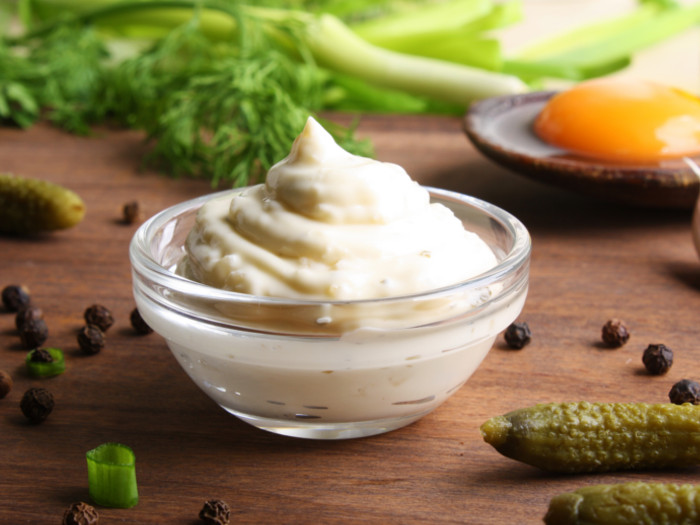The common kitchen item cream of tartar can be used for a variety of goods. Not only is it needed in cooking and cleaning, but it even has some surprising health benefits!
What is Cream of Tartar?
Cream of tartar is scientifically known as potassium bitartrate (or potassium hydrogen tartrate) and is derived through the process of winemaking. This ingredient is commonly used in baking applications, but can also be used as a household cleaner, similar to baking soda. This byproduct is a form of crystal that will precipitate out of grape skins and even wine itself. When used in cooking applications, it can stabilize whip cream and egg whites, as well as prevent sugar crystallization in baking. This acidic salt doesn’t go bad, provided you store it in an airtight container away from sources of heat. [1]
Aside from its culinary applications, it can also be used as a part of natural remedies, particularly as a purgative.

Cream in a bowl Photo Credit: Shutterstock
| Serving Size : | |
|---|---|
| Nutrient | Value |
| Water [g] | 1.7 |
| Energy | 258 |
| Energy [kJ] | 1079 |
| Ash [g] | 36.8 |
| Carbohydrate, by difference [g] | 61.5 |
| Fiber, total dietary [g] | 0.2 |
| Calcium, Ca [mg] | 8 |
| Iron, Fe [mg] | 3.72 |
| Magnesium, Mg [mg] | 2 |
| Phosphorus, P [mg] | 5 |
| Potassium, K [mg] | 16500 |
| Sodium, Na [mg] | 52 |
| Zinc, Zn [mg] | 0.42 |
| Copper, Cu [mg] | 0.2 |
| Manganese, Mn [mg] | 0.21 |
| Selenium, Se [µg] | 0.2 |
| Sources include : USDA [2] | |
Benefits
The potential health benefits of a cream of tartar include its ability to help relieve urinary tract infections (UTI), lower blood pressure, and fight heartburn, among others.
May Help You Quit Smoking
Anecdotal evidence shows that consuming cream of tartar can help you kick your smoking habit; when combined with orange juice, this byproduct is said to make the taste of cigarettes extremely unpleasant. [3]
May Act as a Remedy For Urinary Tract Infections
By possibly changing the pH level of your urine, cream of tartar can help to reduce urinary tract infections (UTIs) by making the environment untenable for bacteria to thrive. [4]
Potential Remedy For Acne
The potential antitoxin and antibacterial nature of cream of tartar mean that consuming just a small amount each day can help prevent the unsightly symptoms of acne. [5]
Potential Remedy for Heartburn
Similar to baking soda, consuming appropriate amounts of cream of tartar is thought by some as an anecdotal method for soothing the symptoms of heartburn. [6]
May Help Improve Arthritis
For those who suffer from chronic inflammation in their joints, this cream can be used topically. Cream of tartar byproduct can be mixed with Epsom salt to make a powerful pain-relieving salt bath.
May Help Improve Edema
A cream of tartar has certain diuretic properties, which can pull some excess fluid from the body. This may clear up some symptoms of edema. It’s wise to always speak with a medical professional before utilizing a cream of tartar for diuretic purposes. [7]
May Aid in Weight Loss
Partly due to its potential diuretic properties, there are some anecdotal reports that mixing cream of tartar into a daily glass of milk can boost weight loss efforts. Besides the taste (ick), this is a home remedy and has no efficacy in scientific research.
Uses
There are many uses for cream of tartar in the daily diet, including as a functional ingredient. Consider including it in the following.
- Pies
- Cookies
- Cakes
- Snickerdoodle cookies
Cream of tartar also has some household uses and can be mixed with white vinegar or lemon juice to form a powerful paste that can clean various types of metal and other surfaces. When combined with hydrogen peroxide, it can help to remove rust from tools. As a home remedy, it can be mixed with lemon juice and Epsom salt and consumed in small quantities as a purgative.
Baking Soda vs Cream of Tartar
While baking soda (sodium bicarbonate) and cream of tartar (potassium bitartrate) are chemically similar and serve similar functions for health and household purposes, they are technically not the same thing.
Cream of tartar has more of a stabilizing effect than baking soda, and each serves a different purpose in baking. You can mix cream of tartar with baking soda to produce a baking powder. Acid is what helps baking soda rise, and this cream byproduct serves that purpose. However, in a batter that already has an acidic element, this cream is unnecessary. [8]
Side Effects
There are some side effects of consuming cream of tartar, including: [9]
- Hyperkalemia: There is a very high level of potassium in this cream, which could result in hyperkalemia (excess potassium in the blood) for those who consume excess amounts or are unable to process potassium properly (i.e. renal patients). [10]
- Dehydration: This substance also has known purgative and diuretic properties, which could result in a loss of liquid in the body. As is well known, dehydration can have a wide range of negative side effects.
